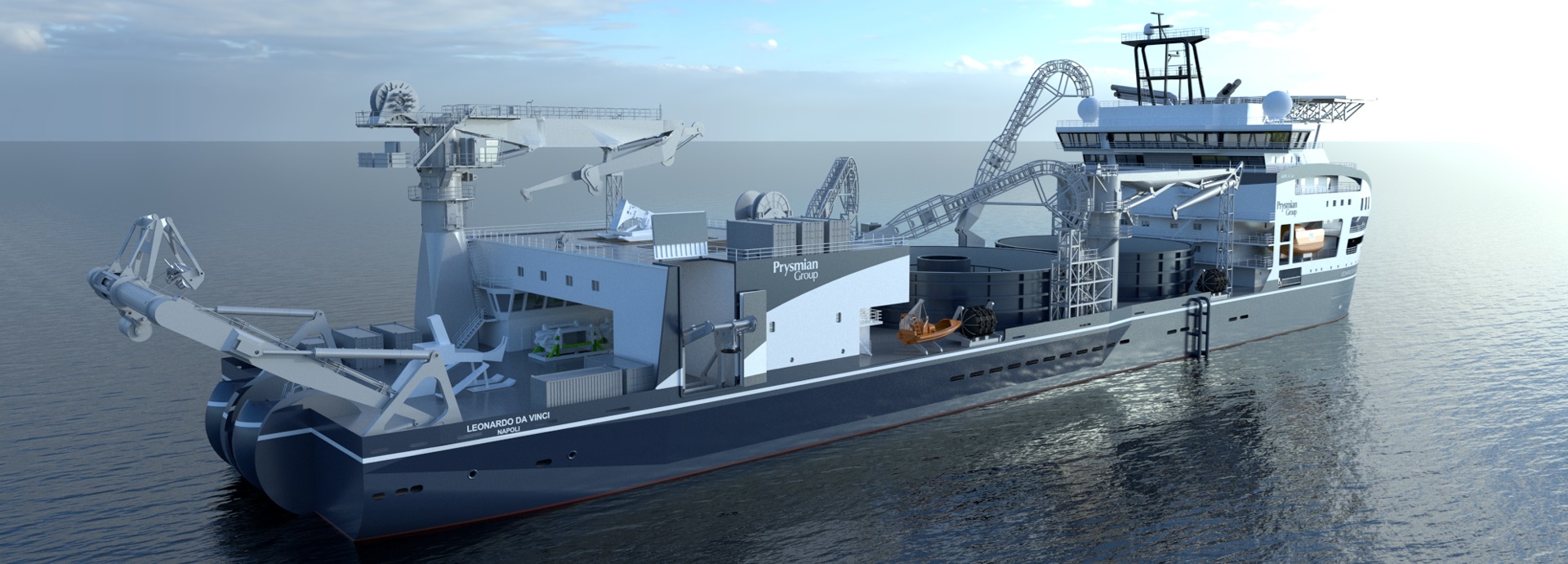

The Prysmian Group is betting on Wärtsilä’s retractable thrusters for the most advanced cable layer vessel in the world. Find out how its use helped Prysmian dramatically reduce installation times, especially during a pandemic, while helping improving efficiency and reliability.
Its lines point to an imposing and eye-catching vessel from any perspective. The Leonarda Da Vinci could have been designed by its more renowned namesake, with its sleek appearance making it appear like something from the space-age. This is only natural
when you consider that it is probably the most advanced cable-laying vessel in the world and is designed to handle the next-generation of cable technologies.
Operated by the Prysmian Group and currently, in the process of being
prepared for final fit-out and finishing, the Leonardo Da Vinci is equipped to carry out the deepest power cable installations of up to 3,000 metres. This is made possible thanks to new generation cable technology armoured with composite material,
based on aramid fibres, and through the use of two massive carousels which it will use to transport and lay the cables – one with a capacity of 7,000 tonnes and the other with a capacity of 10,000 tonnes – the highest capacities available
in the market.
The global submarine cable market is projected to reach USD 26.16 billion by 2025, growing at a CAGR of over 12%. Vessels like the Leonardo Da Vinci will become increasingly important as the world’s demand
for renewable energy grows and the need for interconnectors and cables to link offshore and onshore energy sources rise. In fact, the European Union has made increased investments in renewable energy generation a cornerstone of its strategy to help
the economy recover from the ongoing COVID-19 pandemic and this approach will undoubtedly be replicated globally.
Built for performance
Its heavy-duty capabilities don’t take away from the fact that the Leonardo Da Vinci is also designed to be a more sustainable vessel with automated systems working in tandem with its 120-member crew to improve efficiency, eliminate waste and reduce
emissions across the board. The vessel’s carbon emissions are among the lowest in its class. Key to this is its Dynamic Positioning (DP) system and its propulsion system, which help keep the environmental footprint low.
With
a Bollard pull of about 200 tonnes, it also has the highest pulling/towing capacity in its class. The whole vessel is powered by 6 Wärtsilä engines - four 8V31 and two 8L20. These provide all the electricity needed on the vessel, from propulsion
and mechanical to the hotel load.
The Leonardo Da Vinci is also the first Prysmian cable layer to host the advanced Wärtsilä WST-24R retractable thruster that helps better optimise station-keeping capabilities with
its 8-degree, tilted propeller shaft. This helps minimise potential interactions between the thruster and hull, reducing demands on power while significantly boosting performance.
“One of the characteristics of the WST-24R
is the 8o tilted configuration. By minimising interaction losses, the operational efficiency for operators and owners increases by up to 20%.” Says Arnoud Dinslage, Product Manager Thrusters, Wartsila Marine Power
“ There are other retractable thrusters of this size on the market, but the WST-24R is the only one with the tilted configuration advantage.”

Towards improved efficiencies
A product of extensive R&D by Wärtsilä Marine’s Technology and Service centre in the Netherlands, the new retractable thruster design has been developed keeping the needs of offshore construction vessels, semi-submersible rigs and
versatile cable-laying vessels like the Leonardo Da Vinci in mind.
The new retractable thrusters come loaded with benefits. Its vertical retraction minimises space requirements in vessels and they can also be independently
rotated 360-degrees, making for exceptionally manoeuvrable vessels with high-thrust performance. An improvement over conventional retractable thrusters of up to 20% in thrust effectiveness.
The use of a single-drive cabinet instead
of two to control the motors used for steering and retraction also frees up a lot of space on the vessels. It also means the use of fewer components making maintenance and repair easier.
“Another advantage of the new thruster
is its combined electric steering/retraction system.” continues Dinslage “Together with the unique retraction mechanism this means fewer components which reduces weight and makes installation and maintenance easier without sacrificing
capabilities.”

Making installation and maintenance easy
Maintenance is a top priority and consideration especially when classification societies mandate thruster inspections every 5 years to ensure that they are working in top condition. This often requires dry-docking which means downtime for vessels and
potentially affects the profitability of operations. Wärtsilä’s Propulsion Condition Monitoring Service (PCMS) helps eliminate the need to enter a dry dock for visual inspections, by allowing for underwater inspections of the thrusters
and provides the vessel’s users with in-depth information without having to dismount the thrusters or dismantle any parts.
The use of Wärtsilä’s retractable thrusters made its installation onto the Leonardo
Da Vinci a smooth and efficient affair with the entire unit lifted as one complete package on to the vessel during installation. This helped save the yard time and resources which would otherwise have made the final fitting out of the vessel take
longer.
The unique Plug-and-Play design of the WST-24R thrusters reduces the complexity of installation as the thruster comes pre-assembled and aligned, meaning that installation just requires lowering it into place, levelling and securing it.
The design and expertise of Wärtsilä specialists even allow for remote commissioning if needed, which was put to the test during the installation on the Leonardo Da Vinci due to COVID-19 travel restrictions.
As things stand, the rapid installation helped speed up the process for Prysmian enormously, with the vessel on schedule and delivered in August 2021.
Learn how this approach fits into a broader offshore strategy. Download this white paper: “Offshore gains – How to tackle three challenges and sharpen your edge”
Related solutions
Did you like this? Subscribe to Insights updates!
Once every six weeks, you will get the top picks – the latest and the greatest pieces – from this Insights channel by email.

